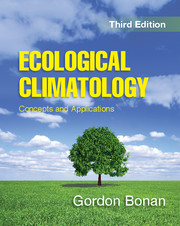Book contents
- Frontmatter
- Dedication
- Contents
- Preface
- 1 Ecosystems and Climate
- Part I The Earth System
- 2 Components of the Earth System
- 3 Global Cycles
- Part II Global Physical Climatology
- Part III Hydrometeorology
- Part IV Biometeorology
- Part V Terrestrial Plant Ecology
- Part VI Terrestrial Forcings and Feedbacks
- Appendix
- Index
- Plate section
- References
2 - Components of the Earth System
from Part I - The Earth System
Published online by Cambridge University Press: 05 November 2015
- Frontmatter
- Dedication
- Contents
- Preface
- 1 Ecosystems and Climate
- Part I The Earth System
- 2 Components of the Earth System
- 3 Global Cycles
- Part II Global Physical Climatology
- Part III Hydrometeorology
- Part IV Biometeorology
- Part V Terrestrial Plant Ecology
- Part VI Terrestrial Forcings and Feedbacks
- Appendix
- Index
- Plate section
- References
Summary
Chapter Summary
Earth's climate is understood in terms of a system of several interacting spheres and the energy, water, and biogeochemical cycles that link these spheres. The main components of the Earth system are: atmosphere, air; hydrosphere, water; cryosphere, frozen portion of Earth; biosphere, living organisms; pedosphere, soil; and anthroposphere, humans. People are important agents of environmental change through land use and land-cover change and co-option of the hydrologic cycle and biogeochemical cycles. Numerous physical, chemical, and biological processes within the Earth system feed back to accentuate or mitigate climate change. Many of these feedbacks relate to terrestrial ecosystems and human activities. Greater understanding of Earth and its climate requires that all components of the Earth system – physical, chemical, biological, socioeconomic – be considered.
Atmosphere
The atmosphere is the air that surrounds Earth. It is comprised primarily of nitrogen (N2) and oxygen (O2), which together account for 99 percent of the volume of the atmosphere (Table 2.1). Many other gases occur in trace amounts that when combined comprise less than 1 percent of the volume of the atmosphere. Although they occur in minor quantities, some of these gases play an important role in Earth's radiation balance through the greenhouse effect.
Air pressure is a measure of the mass of air above a given point. The total pressure exerted by a parcel of air is the sum of the pressures of all the individual gases in the parcel. Nitrogen, which comprises 78 percent of the air, exerts the most partial pressure, followed by oxygen (21%). Water vapor typically comprises 1–4 percent of air. For example, the atmospheric pressure near sea level is about 1000 hectopascals (hPa, 1 hPa = 100 Pa = 1 millibar). The partial pressure of nitrogen is 780 hPa and oxygen is 210 hPa. If water vapor comprises 1 percent of the parcel, its partial pressure is 10 hPa or 1000 Pa. Because water vapor is only a small constituent of air, vapor pressure is only a small component of total air pressure. Carbon dioxide has a partial pressure of about 40 Pa.
Greenhouses gases are poor absorbers of solar radiation, but are strong absorbers of longwave radiation. As a result, the Sun's radiation passes through the atmosphere and heats the surface, but greenhouse gases in the atmosphere absorb the longwave radiation emitted by the surface.
- Type
- Chapter
- Information
- Ecological ClimatologyConcepts and Applications, pp. 23 - 39Publisher: Cambridge University PressPrint publication year: 2015



